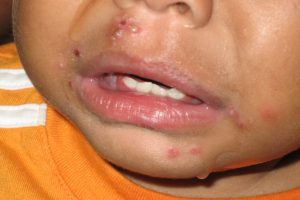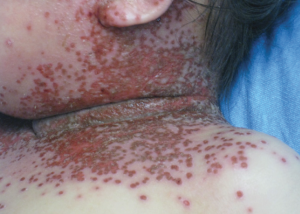Chapter 6: Infections and Infestations
Viral Infections: Herpes Simplex Virus 1 and 2
Herpes Simplex Virus infection is very common and can be caused by either HSV1 or HSV2. These two viruses have a predilection for mucosal skin and so are seen most commonly in the mouth and in the groin area. HSV 1 is the most common cause of orolabial HSV (commonly known as cold sores), while HSV 2 is more commonly associated with genital lesions and is seen most commonly as a sexually transmitted infection. However, either form of the virus can be seen in either location, and both have been associated with non-mucosal infections as well.
What does it look like?
Lesions appear as grouped vesicles on an erythematous base. They are often painful and may cause swelling of the lips. A prodrome of tingling or burning may be felt in the 24 hours before the blisters appear. Symptoms are generally worse with first infections and are somewhat milder with recurrent infections. Recurrences are frequent in times of stress, after significant sun exposure or when the immune system is weakened.

Note small ulceration on mucosal lip
How is it diagnosed?
Classic lesions can be diagnosed clinically, but a viral swab for PCR is a rapid and sensitive method to confirm the diagnosis. The swab should sample the moist base of a recently ruptured vesicle. If the vesicle is still intact this will require deroofing, which can be achieved with a small needle.
How is it treated?
For first infections, treatment is with a short course of acyclovir. Treatment of most recurrent infections is supportive with topical anesthetics. Patients with frequent recurrences can be give na prescription that they begin when the tingling sensation is first noted. For patients with particularly bothersome and frequent recurrences, suppression with acyclovir or valacylocvir can decrease the frequency of outbreaks.

Other manifestations of HSV:
- Herpetic Whitlow: HSV lesions on the fingertips due to transfer from oral lesions by direct contact.
- Eczema herpeticum: Widespread skin involvement with HSV 1 in the setting of an underlying skin disease such as atopic dermatitis. These patients require hospitalization, isolation, and IV acyclovir therapy.
- Recurrent erythema multiforme: One of the most common causes of recurrent EM is HSV. These patients usually require treatment with suppressive acyclovir.
- Neonatal HSV: A medical emergency. Transmission from mother to neonate during delivery is most commonly seen in the mother’s first infection and outbreak. Often mothers are asymptomatic at the time of delivery.

